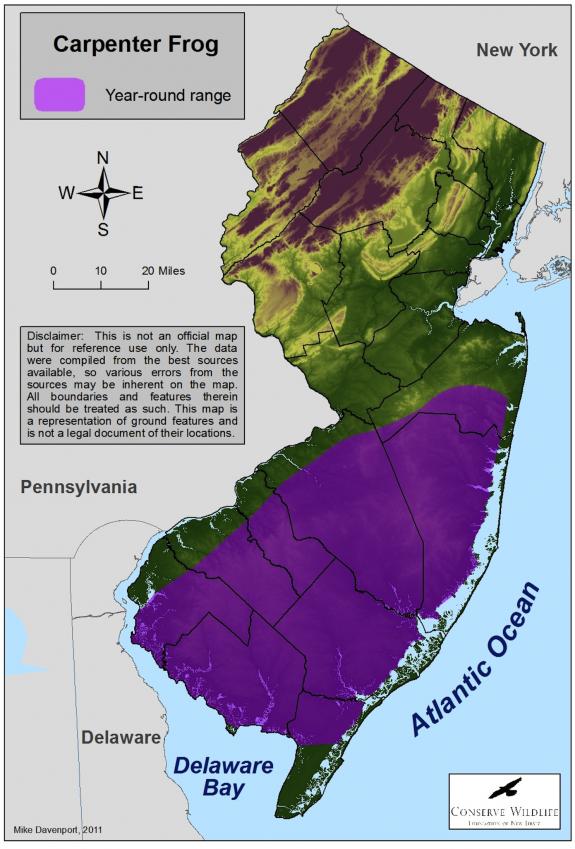Lithobates virgatipes
Type: amphibian
Status: special concern
Species Guide
Carpenter frog
Lithobates virgatipes
Species Type: amphibian
Conservation Status: special concern
IDENTIFICATION
Carpenter frogs get their name from the call they make which sounds like a carpenter hammering. This frog is a medium sized frog ranging from 4.1 to 6.7cm. The color of the species is entirely brown with four yellowish stripes that run down the back and sides of the frog. The tail is grayish with large spots. The underbelly of the frog is usually a white to yellow color.
This species’ most unique feature is that the webbing on its feet does not reach the tip of the longest toe. The carpenter frog is often confused with other similar species; however the webbing is the best way to tell them apart. Carpenter frogs are equipped with paired throat pouches that are spherical when inflated. This species is a nocturnal animal, which is often heard but not seen.

Distribution & Habitat
This species is found in the Atlantic Coastal Plain ranging from the New Jersey Pine Barrens to southern Georgia. Within New Jersey, they are found in most of the southern half of the state except parts of Salem, Camden, Gloucester, and Cape May Counties. They are exceptionally aquatic frogs, barely wandering on land. They like tea colored, still water with an abundance of aquatic vegetation. These habitats include pine savanna ponds, cypress ponds, swales, sphagnum bogs, and acid swamps because they have adapted to high acidic levels in water.
Diet
Adult carpenter frogs eat crayfish, spiders, and other invertebrates, while their tadpoles eat algae, plant tissue, organic matter, and possibly very small invertebrates.
Life Cycle
The carpenter frog’s breeding period is from April to August. The female lays about 200-600 eggs at a time. The egg masses are usually attached to underwater vegetation. The larvae develop in pools. The tadpoles take about a year to develop and grow to about 3.5 inches. More developed tadpoles have a distinct line in their dorsal tail fin.
Current Threats, Status, and Conservation
Although the carpenter frog can be found throughout southern New Jersey, their population has been declining and needs to be monitored. The greatest threat to this species is loss or destruction of habitat. Due to population declines and habitat loss, the carpenter frog was listed as a species of special concern in New Jersey.
Scientific Classification
- Kingdom: Animalia
- Phylum: Chordata
- Class: Amphibia
- Order: Anura
- Family: Ranidae
- Genus: Lithobates
- Species: L. virgatipes